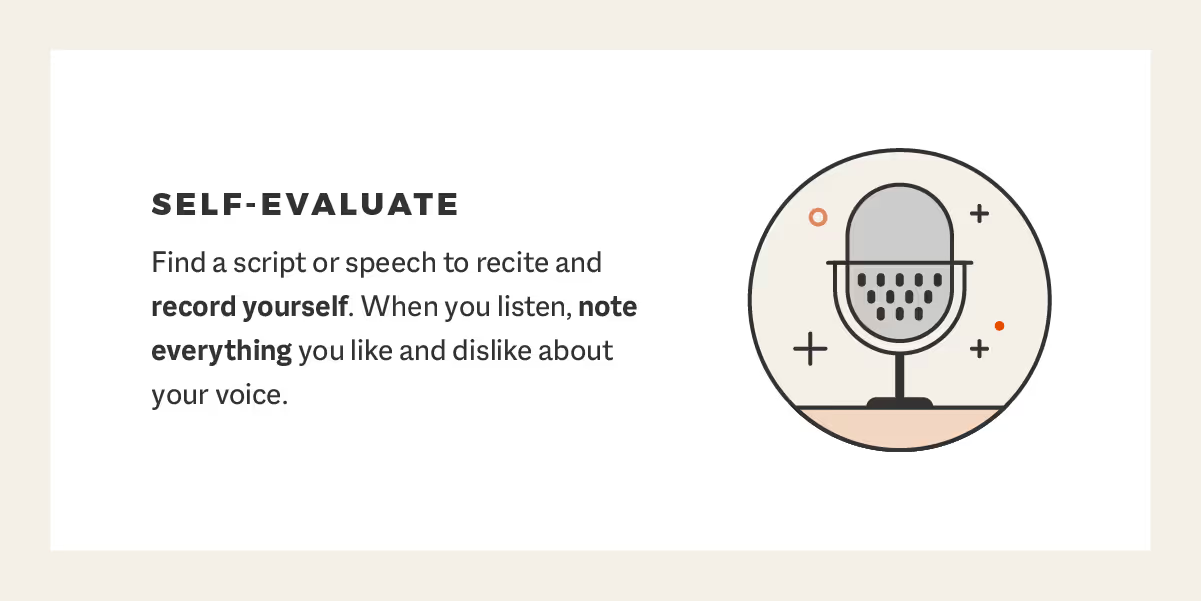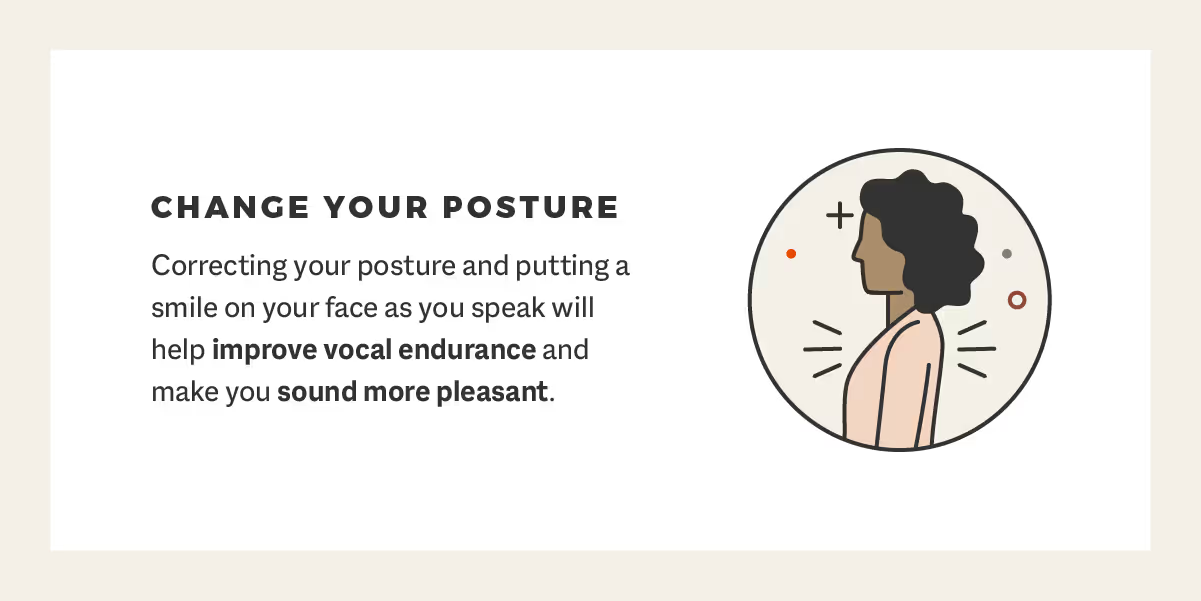How To Make Your Professional Voice Sound Better in 10 Steps
How To Make Your Professional Voice Sound Better in 10 Steps

As an established business professional, you’ve mastered the firm handshake, professional appearance, and typical workplace etiquette. But what about your voice?
Like your physical appearance, your voice is a part of you and is just as important as any other sensory impression. After all, before people hear what you say, they hear how you say it. This could possibly alter the perception of you and your business.
Maybe you don’t like the sound of your voice or weren't naturally born with the talent of an eloquent receptionist. Luckily, sounding more professional at work is a skill, and skills can be developed.
If you are seeking advice on how to make your “work voice” sound better, keep reading to find out the importance of establishing a business voice, as well as 10 simple steps that will help you develop the engaging and professional voice you desire.
Why your “business voice” matters
The voice you use in a professional environment is much different than the casual voice you would use at home or when talking with close friends. A business voice should be:
- Clear and easy to understand
- Articulate with word choice
- Engaging to captivate your audience
- Low-toned rather than high-pitched
- Varied with pitch to help draw attention
Whether you are engaging with clients, making sales calls, or hosting a webinar, a quality business voice is an essential part to the success of your business. While this may sound dramatic, research shows that vocal tone matters because it creates perceptions about you and your business.
Perception plays a major role in business, as it helps them grow and survive in the market and provides perspective that will help develop leading business opportunities.
With the rise of the virtual workplace, more and more business interactions are happening via phone calls. In these cases, your voice is the main sensory perception of you and your business — which makes your business voice that much more important.

10 steps to make your voice sound better
To help you develop a clear, professional, and overall better-sounding voice, follow these simple steps that will help you establish the business voice you desire.
Step 1: Record yourself and evaluate
The first step to making your voice sound better is to listen to yourself talk via recording. While this part may make you grimace, know you aren’t alone. Many people hate the sound of their voice, but it’s the only way to truly evaluate yourself. You may even surprise yourself! You probably don’t sound as bad as you think you do.
Find a script or speech to recite and record yourself. When you listen, make sure you take note everything you notice, including:
- Volume: Do you speak loudly or softly?
- Voice quality: Is your voice nasally, breathy, or raspy?
- Enunciation: Do you slur or mumble your words?
- Speed: Do you speak too quickly or slowly?
- Pitch: Do you speak in a high or low pitch?
- Pitch variation: Do you speak in a monotone voice?
These categories make up your entire vocal profile and are key elements to helping you evaluate your voice. Listen back to the recording and take note of everything you like and dislike about your voice.

Step 2: Listen to good speakers
Now that you’ve gotten the worst part out of the way, you can move on to the next step, which is listening to professional speakers. Part of developing a business voice is familiarizing yourself with professional speakers and noting the aspects that make them good.
Watch Ted Talks or download podcasts and audiobooks and give yourself some time to listen to their voice. Pay attention to the control professionals have over their voice and how they change their pitch to emphasize specific words or statements.
If you do this regularly, you’ll be able to implement what you like about the way that they speak into your own voice.
Step 3: Improve your breathing
Every speech starts with a breath, so improving your breathing techniques is a great place to start when trying to make your voice sound better. You’ll want to make sure you breathe slow and steady from the diaphragm. This will help protect your voice from strain and embody a richer, more consistent speaking tone.
To practice, read a paragraph aloud that contains a mix of long and short sentences. Take a deep breath and exhale gradually as you read each sentence. However, don’t feel like you must fill your lungs to capacity — take as much air as you need for easy and comfortable breathing so that you don’t sound breathy. This exercise helps you improve your breath strength and technique.

Step 4: Slow down your speech
It’s common to get nervous during a big speech or an important sales call. When you’re nervous, your speech tends to get faster. This will make you sound less confident or passionate and can make it harder for the listener to understand you.
By slowing down your speech, you can breathe deeply, enunciate better, and more thoughtfully consider what you’re trying to say. Be mindful when you slow down that you aren’t making your speech sound tedious and drawn out — slow down just enough to really give a clear and confident dialogue.
Step 5: Mind your pitch
Depending on what you assessed during your self-evaluation, you may or may not have a lot of work to do when it comes to pitch. If you find your voice to be shrill, husky, or even flat, it’s time to work on your pitch. The ideal speaking pitch sounds low, clear, full, and varied.
Pitch variation is very important, as it emphasizes different parts of a sentence which will add interest and emotion and help you get your point across. Even the slightest inflection (raised pitch) of a word can change the meaning or implication of a sentence.

Step 6: Practice your timing
Timing is everything in a good speech or presentation, as it benefits not only the listeners, but yourself as the speaker. Added pauses or wait time between sentences gives your listeners time to process and understand what you are saying. It also gives you extra time to slow down your train of thought and take breaths as needed, which will help you sound less breathy.
A well-placed break can also emphasize the point you are trying to make, which will help draw more attention from your listeners. While you practice, play around with your pauses to see what sounds the most natural and effective for what you are trying to say.
Step 7: Change your body language
Your voice doesn’t just emerge from your throat — it arises from your entire body. Changing your body language can impact the tone of your voice and make you not only sound — but feel — more confident.
For instance, poor posture such as slouching can strain your throat muscles and make it harder for you to breathe with your diaphragm. This can reduce your vocal endurance and make you sound more tense and forced. To fix posture-related vocal problems, sit up straight, engage your core, and relax your shoulders.
Additionally, putting a smile on your face while you are on the phone makes you sound more pleasant and engaging. Give it a try:
Record yourself saying something simple like, “Hello my name is ___, how are you today?”, then record yourself saying the same thing with a smile. You’ll be amazed at how much your smile comes through in your voice.

Step 8: Stay hydrated
Hydration is key to not only a healthy body and mind, but your voice as well. Drinking plenty of water will help lubricate and protect your vocal cords which will help you sound better and more clear to your listeners. You’ll also want to avoid things that dehydrate you, such as alcohol or smoking — which can make your voice sound raspy and hoarse.
While we are on the topic, it’s also important to avoid foods that may trigger indigestion, heartburn, or acid reflux. These issues can cause symptoms like eructation (AKA burping), which can embarrassingly interrupt your presentation.
Step 9: Try warm-up exercises
Famous singers and actors use vocal exercises and techniques for a reason. A warm-up vocal exercise allows you to sound your best while helping keep your voice healthy and protected. It’s essential for anyone who uses their voice as a means to perform, including those who give public speeches, speak on podcasts, or even conduct daily sales calls.
A simple and quick exercise to help you relax your voice is the yawn-sigh technique. Take in a relaxed and gentle breath as if you were yawning. Then, exhale as if you are sighing. Repeat this exercise by adding in different vowel sounds like “oo,” “ahh,” and “ee” as you exhale.
You can even do physical exercises like the hanging jaw technique. With a relaxed mouth and jaw, exaggerate the movements of your face as you talk. Open your mouth wide as you make “oh” and “ah” sounds while allowing your jaw to drop low. It may feel silly, but this will help decrease jaw tension that affects your voice range and quality.

Step 10: Seek out assistance and feedback
After your self-assessment and practice, the last step is to seek advice and feedback from others. Once you feel like you’ve attained the business voice you desire, ask a friend or mentor for their honest feedback.
If you still feel like you are struggling with your speaking voice, an effective way to make your voice sound better is to invest in a voice coach. A voice coach can give you actionable tips and practice sessions that will help you create the perfect business voice.
Getting involved in a drama club could also help you improve the way your voice comes across and will make you feel more confident speaking in front of an audience.

Hire Smith.ai professionals
Learning how to make your voice sound better is a great skill to develop as it helps you communicate efficiently, sound professional, build better personal connections, and can provide a positive perception of you and your business.
At Smith.ai, our team of skilled virtual receptionists is available to assist with most frontline business communications tasks that you need. Whether it’s 24/7 phone answering, lead screening and intake, or outbound prospecting and sales, we offer various features that will support clear and rapid business communication for your business. To learn more, schedule a consultation to discuss how Smith.ai virtual receptionists can help.
Sources: Maria Pellicano | Donna Stone | ToastMasters | Healthline | School of Rock | SLT Info | Wonder of Voice
Take the faster path to growth. Get Smith.ai today.
Key Areas to Explore
Technical Implementation Terms
Voice user interface (VUl) design
Speech recognition integration
Text-to-speech optimization
API connectivity and webhooks
Real-time data synchronization

Your submission has been received!












%20(1)%20(1).avif)

.svg)



